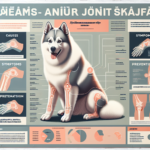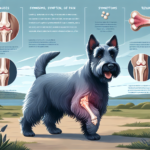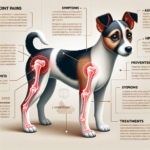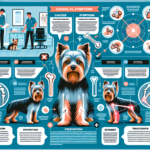Curly-Coated Retriever Joint Pain: Causes, Symptoms, Prevention, and Treatment
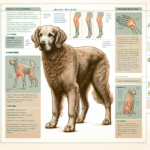
Introduction
The Curly-Coated Retriever is a distinctive and versatile breed known for its unique curly coat and exceptional retrieving abilities. Originating in England, this breed was developed in the late 18th century by crossing the now-extinct English Water Spaniel with the Poodle and other retrievers. The Curly-Coated Retriever is celebrated for its intelligence, agility, and endurance, making it a popular choice for hunting, field trials, and as a loyal family companion.
Like many breeds, the Curly-Coated Retriever is prone to certain health issues, with joint pain being a significant concern. Joint health is crucial for this breed due to its active lifestyle and working heritage. Ensuring the well-being of their joints can help maintain their quality of life and prolong their active years.
Breed-Specific Joint Pain Risks
Genetic Predisposition
The Curly-Coated Retriever, like many large breeds, is genetically predisposed to joint-related issues such as hip dysplasia, elbow dysplasia, and arthritis. Hip dysplasia is a condition where the hip joint does not fit properly into the hip socket, leading to pain and mobility issues. Elbow dysplasia involves abnormal development of the elbow joint, causing lameness and discomfort. Arthritis, a degenerative joint disease, can also affect this breed, leading to chronic pain and stiffness.
Age-Related Risks
As Curly-Coated Retrievers age, the risk of developing joint pain increases. Typically, signs of joint issues may start to appear in middle age, around 5 to 7 years old. However, some dogs may show symptoms earlier or later, depending on their genetic makeup and lifestyle. It’s essential for owners to monitor their dogs for any signs of discomfort as they age and to take proactive measures to support joint health.
Activity Level and Joint Stress
The Curly-Coated Retriever is an active and energetic breed, often engaged in activities such as hunting, agility, and obedience training. While regular exercise is beneficial for overall health, excessive or high-impact activities can put additional stress on their joints. Owners should balance their dog’s activity level to prevent overexertion and potential joint damage.
Common Symptoms of Joint Pain in Curly-Coated Retrievers
General Symptoms
- Limping or favoring one leg
- Stiffness, especially after rest or exercise
- Reluctance to jump, run, or climb stairs
- Decreased activity or interest in play
- Swelling around the joints
- Whining or showing signs of discomfort when touched
Breed-Specific Symptoms
In Curly-Coated Retrievers, joint pain may manifest as a noticeable change in their gait or reluctance to engage in activities they previously enjoyed. Due to their high pain tolerance, they might not show obvious signs of discomfort until the condition has progressed. Owners should be vigilant and look for subtle changes in behavior or movement.
When to Consult a Vet
If you notice any of the above symptoms in your Curly-Coated Retriever, it’s essential to consult a veterinarian promptly. Early diagnosis and intervention can significantly improve the prognosis and quality of life for dogs with joint pain. Regular veterinary check-ups are also crucial for monitoring joint health and catching any issues early.
Preventive Measures for Joint Health
Exercise Recommendations
Regular, moderate exercise is vital for maintaining joint health in Curly-Coated Retrievers. Activities such as swimming, walking, and controlled play can help keep their joints flexible and muscles strong without causing excessive stress. Avoid high-impact activities like jumping or running on hard surfaces, which can exacerbate joint issues.
Dietary Suggestions
A balanced diet rich in essential nutrients can support joint health. Consider incorporating foods or supplements that contain glucosamine, chondroitin, and omega-3 fatty acids, which are known to promote joint health and reduce inflammation. Consult your veterinarian for specific dietary recommendations tailored to your dog’s needs.
Weight Management
Maintaining a healthy weight is crucial for reducing joint stress in Curly-Coated Retrievers. Excess weight can exacerbate joint pain and lead to other health issues. Monitor your dog’s weight regularly and adjust their diet and exercise routine as needed to keep them at an optimal weight.
Early Screening and Monitoring
Regular veterinary check-ups and early screening for joint issues can help catch problems before they become severe. Your veterinarian may recommend X-rays or other diagnostic tests to assess joint health, especially if your dog is genetically predisposed to joint conditions. Early intervention can significantly improve outcomes and quality of life.
Treatment Options for Joint Pain
Non-Surgical Treatments
Non-surgical treatments for joint pain in Curly-Coated Retrievers include medications, physical therapy, and lifestyle adjustments. Anti-inflammatory drugs and pain relievers can help manage symptoms, while physical therapy can improve mobility and strengthen muscles. Lifestyle changes, such as providing a comfortable bed and avoiding high-impact activities, can also alleviate joint pain.
Surgical Options
In severe cases, surgical intervention may be necessary to address joint pain. Common surgeries for joint issues include hip replacement, arthroscopy, and joint fusion. These procedures can significantly improve mobility and reduce pain, but they come with risks and require a thorough discussion with your veterinarian to determine the best course of action.
Alternative Therapies
Alternative treatments such as acupuncture, hydrotherapy, and massage can also benefit Curly-Coated Retrievers with joint pain. Acupuncture can help reduce pain and inflammation, while hydrotherapy provides low-impact exercise that strengthens muscles without stressing the joints. Massage therapy can improve circulation and alleviate muscle tension, contributing to overall joint health.
Lifestyle and Management Tips
Daily Care Routine
A consistent daily care routine can help manage and alleviate joint pain in Curly-Coated Retrievers. This routine might include gentle exercise, a balanced diet, and regular administration of any prescribed medications or supplements. Monitoring your dog’s behavior and adjusting their routine as needed can also help manage symptoms effectively.
Modifying the Home Environment
Making your home more comfortable for a dog with joint pain can significantly improve their quality of life. Consider adding ramps to help them navigate stairs, providing orthopedic beds for better support, and ensuring their living area is free of slippery surfaces that could cause falls.
Long-Term Management
Long-term management of joint pain involves regular veterinary check-ups, ongoing monitoring of symptoms, and adjustments to your dog’s care routine as needed. Keeping your dog active and engaged with low-impact activities can help maintain their mobility and overall well-being. Additionally, maintaining open communication with your veterinarian ensures that any changes in your dog’s condition are promptly addressed.
FAQs About Curly-Coated Retrievers and Joint Pain
What are the early signs of joint pain in Curly-Coated Retrievers?
Early signs of joint pain include limping, stiffness, reluctance to move, and changes in behavior or activity levels. If you notice any of these symptoms, consult your veterinarian for a thorough evaluation.
Can joint pain in Curly-Coated Retrievers be prevented?
While genetic predisposition cannot be changed, preventive measures such as regular exercise, a balanced diet, weight management, and early screening can help reduce the risk and severity of joint pain.
Are there specific exercises that are better for Curly-Coated Retrievers with joint pain?
Low-impact exercises like swimming and walking are ideal for dogs with joint pain. These activities help maintain muscle strength and joint flexibility without causing excessive stress on the joints.
What dietary supplements are recommended for joint health in Curly-Coated Retrievers?
Supplements containing glucosamine, chondroitin, and omega-3 fatty acids are commonly recommended for joint health. Always consult your veterinarian before adding any supplements to your dog’s diet.
When should I consider surgical options for my dog’s joint pain?
Surgical options should be considered when non-surgical treatments are no longer effective, and your dog’s quality of life is significantly impacted. Discuss the potential benefits and risks with your veterinarian to make an informed decision.
Conclusion
Joint pain is a significant concern for Curly-Coated Retrievers, but with proper care and preventive measures, it can be managed effectively. Regular exercise, a balanced diet, weight management, and early screening are crucial for maintaining joint health. If joint pain does develop, a combination of non-surgical treatments, surgical options, and alternative therapies can help alleviate symptoms and improve your dog’s quality of life. By staying vigilant and proactive, you can ensure that your Curly-Coated Retriever remains active, happy, and healthy for years to come.
Remember to consult your veterinarian regularly to monitor your dog’s joint health and make any necessary adjustments to their care routine. Taking these steps will help your Curly-Coated Retriever enjoy a long, active, and pain-free life.

